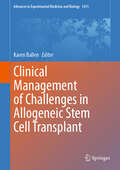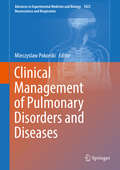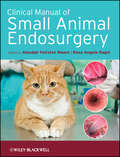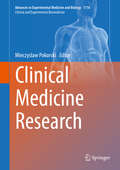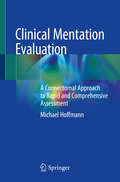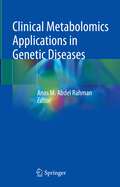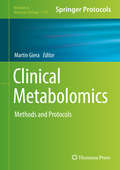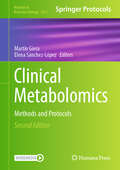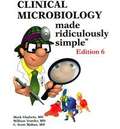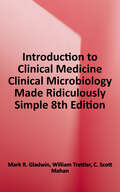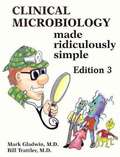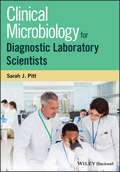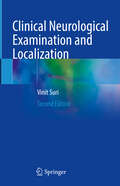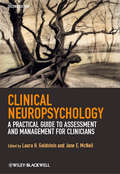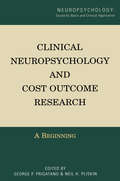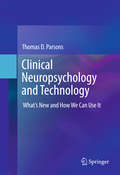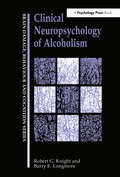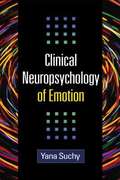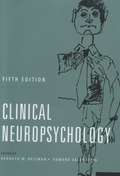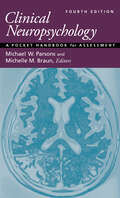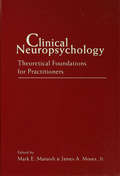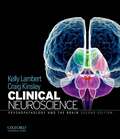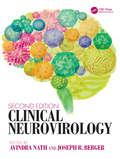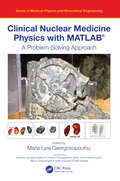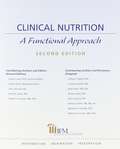- Table View
- List View
Clinical Management of Challenges in Allogeneic Stem Cell Transplant (Advances in Experimental Medicine and Biology #1475)
by Karen BallenThe purpose of the book is to focus attention and offer suggestions on controversial and challenging topics in allogeneic stem cell transplant. Over 40,000 allogeneic hematopoietic cell transplants (HCT) are done worldwide each year. Despite advances in allogeneic transplant, the cure rate is only 50-70%, depending on disease and patient factors. The book focuses on key topics such as patient selection, donor selection, conditioning regimens, graft vs. host disease prophylaxis regimens, maintenance strategies, and other topics that affect patient outcomes. The authors also discuss access to transplant care. Through dissemination of these topics, we hope to educate health care professionals caring for these patients, and improve patient outcomes. This is an essential resource for transplant physicians, hematologists/oncologists, and advance practice providers. Several of the topics are controversial issues that are discussed “round the table” frequently by transplant teams.
Clinical Management of Pulmonary Disorders and Diseases (Advances in Experimental Medicine and Biology #1022)
by Mieczyslaw PokorskiThe book endeavors to provide a stimulating and thought provoking scientific content to share and exchange new clinical studies and advancements in dealing with pulmonary diseases. The topics vary from clinical to translational research in respiratory diseases such as lung cancer, obstructive sleep apnea, chronic obstructive pulmonary disease, bacterial and fungal infections, lung lesions during febrile maladies, and others. An attempt has been made to show the intertwined relationship between the pulmonary system and other body systems such as kidney, cardiac, or hormonal functions. The ensuing interlocked morbidities, often exacerbating one another, require the coordination of various medical specialties to optimize the diagnostic and therapeutic processes. The knowledge sharing through publications of research and clinical experiences is indispensable to accelerate the innovation spectrum and to continue working on the therapeutic and preventive strategies in chronic pulmonary diseases. The book is addressed to pulmonologists, chest physicians, researchers, and healthcare professionals engaged in patient care.
Clinical Manual of Small Animal Endosurgery
by Alasdair Hotston Moore Rosa Angela RagniA practical and comprehensive guide to rigid endoscopy and endosurgery in small animal practice. Fully illustrated throughout, it covers the clinical treatment of small animals from pre-operative through to post-operative care. With reference to specific procedures, this manual includes guidance on the selection of equipment, surgical techniques, anaesthesia and possible complications. A specialist chapter advising on the treatment of birds, reptiles and small mammals is also included.Clinical Manual of Small Animal Endosurgery will enable veterinarians to develop and improve their endoscopic techniques in clinical practice, as well as providing guidance on referral options for more complex cases.KEY FEATURES* Provides comprehensive information on how to perform rigid endoscopic investigations and procedures.* The focus is on dogs and cats with a specialist chapter covering the treatment of exotic small animals* Contains many full colour clinical photographs* Written and edited by experts in the field
Clinical Medicine Research (Advances in Experimental Medicine and Biology #1116)
by Mieczyslaw PokorskiThis book presents an update on new trends and developments in broadly defined medical disciplines. The whole range of multidisciplinary topics are tackled, regarded as being important for advancing the understanding of disease pathogenicity, diagnostic methods, and patient management. The topics include a holistic approach to physiotherapy, with proprioceptive neuromuscular facilitation at the core of it, potential ways to protect kidneys during ischemic coronary interventions, and psychosocial aspects in cancer survivors. Other topics deal with growth hormone deficiency in short children and responses of molecular markers of bone metabolism to growth hormone replacement therapy and with the modern use of transcranial laser-induced photobiomodulation showing surprising benefits in autism disorder. The expert contributions take on the challenges presented to medical professionals by ever growing medical knowledge and various individual and contextual issues that require a multidisciplinary approach in patient management. The authors present a bench-to-bed clinical research to make useful additions to the knowledge on contemporary diagnostic procedures, therapy, and quality of life of patients. The book aims to provide stimulus for new research ideas and to give new perspectives on practical clinical issues. The book is intended for primary care clinicians, family physicians, medical scholars, and other clinicians who treat and manage patients.
Clinical Mentation Evaluation: A Connectomal Approach to Rapid and Comprehensive Assessment
by Michael HoffmannThis first-of-its-kind book offers clinicians a unique and comprehensive system of cognitive and behavioral testing that is tiered and context-appropriate for the diagnosis of mental status. Because the challenge nowadays with neurologic syndrome presentations is no longer merely lesion localization, but the degree, extent and nature of a cognitive and/or behavioral impairment, this work proposes a more targeted system of mentation evaluation -- one that incorporates behavioral, neurological, neuropsychiatric, and neuropsychological components. Developed by synthesizing outcomes data from a range of stroke registries, this novel work offers a stepwise, hierarchical approach to mentation evaluation largely determined by level of consciousness and degree of cooperation. Organized across 14 chapters, the book begins with an introduction to the challenges of cognitive and behavioral assessment, as well as a discussion of various clinical presentations ranging from mild behavioral impairment to cognitive reserve and its implications. Subsequent chapters then address various approaches to mental status evaluation and explore how these tests affect brain physiology. The work closes with a unique discussion of the various lay populations that may benefit from cognitive and behavioral evaluation. Authored by a renowned expert in the field, Clinical Mentation Evaluation: A Connectomal Approach to Rapid and Comprehensive Assessment is an invaluable reference that seeks to revitalize neurological and psychiatric disease measurement within the clinical setting. The work will be of interest to all clinicians in training and clinical practice who regularly, or even periodically, conduct mental status examination.
Clinical Metabolomics Applications in Genetic Diseases
by Anas M. Abdel RahmanThis book helps readers discover the forefront of personalized medicine on clinical metabolomics and its applications in genetic diseases. This comprehensive guide offers a functional relationship map between cell components and genetic variations in various diseases, providing insights that can be applied to personalized medicine. The book covers the latest developments in metabolomics for health, with practical guidance for clinical experts looking to advance their laboratory techniques and career. The metabolomics profile is a powerful tool that has revolutionized our understanding of the relationship between genetics, clinical readouts, and disease outcomes. By integrating metabolomics with genomics and clinical phenotypes, the authors have developed diagnostic and prediction models that have vastly improved patient outcomes and deepened the understanding of disease mechanisms. This model has been successfully applied in various conditions, including inborn errors of metabolism, primary immunodeficiency, and endocrine disorders. However, integrating metabolomics with other omics datasets and clinical phenotypes requires careful study design, analytical tools, and data analysis and interpretation. This groundbreaking new book provides essential guidance for researchers, students, and professionals looking to leverage metabolomics in their own work, including biochemical and clinical geneticists, pharmacogenomics and pharmacometabolomics experts, pharmaceutics and diagnostic researchers, medical scientists, clinical dietitians, metabolic engineers, clinical chemists, and personalized medicine specialists.
Clinical Metabolomics: Methods and Protocols (Methods in Molecular Biology #1730)
by Martin GieraThis detailed volume presents a comprehensive compendium of clinical metabolomics protocols covering LC-MS, GC-MS, CE-MS, and NMR-based clinical metabolomics as well as bioinformatics and study design considerations. The methodologies explored here form the core of several very promising initiatives evolving around personalized health care and precision medicine, which can be seen as complimentary to the field of clinical chemistry and aid the aforementioned field with novel disease markers and diagnostic patterns. Written for the highly successful Methods in Molecular Biology series, chapters include brief introductions to their topics, lists of the necessary materials and reagents, step-by-step, readily reproducible laboratory protocols, and tips on troubleshooting and avoiding known pitfalls. Authoritative and practical, Clinical Metabolomics: Methods and Protocols aims to serve as the basis for successful communication between scientists from several fields, including chemists, biologist, bioinformaticians, and clinicians, ultimately leading to effective study design and completion.
Clinical Metabolomics: Methods and Protocols (Methods in Molecular Biology #2855)
by Martin Giera Elena Sánchez-LópezThis second edition volume presents new and updated protocols on comprehensive compendium of clinical metabolomics protocols covering LC-MS, GC-MS, CE-MS, and NMR-based clinical metabolomics as well as bioinformatics and study design considerations. Chapters explore the core of several promising initiatives evolving around personalized health care and precision medicine. Written for the highly successful Methods in Molecular Biology series, chapters include brief introductions to their topics, lists of the necessary materials and reagents, step-by-step, readily reproducible laboratory protocols, and tips on troubleshooting and avoiding known pitfalls. Authoritative and cutting-edge, Clinical Metabolomics: Methods and Protocols, Second Edition aims to be a useful and practical guide to new researchers and experts looking to expand their knowledge.
Clinical Microbiology Made Ridiculously Simple
by Mark Gladwin William Trattler C. Scott MahanA brief, clear, thorough, and highly enjoyable approach to clinical microbiology, brimming with mnemonics, humor, summary charts and illustrations, from AIDS to flesh-eating bacteria to ebola, mad cow disease, hantavirus, anthrax, smallpox, botulism, etc. Significant updates. Excellent Board review.
Clinical Microbiology Made Ridiculously Simple
by William Trattler C. Scott Mahan Mark R. GladwinThis book attempts to facilitate the learning of microbiology by presenting the information in a clear and entertaining manner brimming with memory aids. The text has been updated to include current information on rapidly developing topics, such as HIV and AIDS (vaccine efforts and all the new anti-HIV medications), Avian Influenza H5N1, SARS Coronavirus, Ebola virus, Hantavirus, E. coli outbreaks, Mad Cow Disease, brand-new antimicrobial antibiotics, and agents of bioterrorism. <p><p>The mnemonics and cartoons in this book do not intend disrespect for any particular patient population or racial or ethnic group but are solely presented as memory devices to assist in the learning of a complex and important medical subject.
Clinical Microbiology for Diagnostic Laboratory Scientists
by Sarah Jane PittA modern, evaluative, and integrative approach to diagnostic microbiology encouraging problem-solving in the clinical laboratory context through the use of examples to illustrate clinical and diagnostic issues Clinical Microbiology for Diagnostic Laboratory Scientists is designed to encourage readers to develop a way of thinking that can be applied to any diagnostic scenario in microbiology. Through consideration of a selected range of infections caused by pathogenic bacteria, viruses, fungi, protozoa, and helminths, the book encourages readers to explore connections between the available information about clinical symptoms, pathogenesis of infections, and the approaches used in laboratory diagnosis, in order to develop new insights. The book begins with an introductory chapter that outlines the scope of clinical diagnostic microbiology and the key areas for the laboratory scientist to be aware of. The subsequent six chapters review a type of infection in depth, using particular pathogenic microorganisms to illustrate salient points. At the end of each chapter there are three exercises related to management of a diagnostic service and assessing the suitability of test methods to specific contexts. There are no right or wrong answers to these, but the reader can discuss them with their laboratory colleagues or university tutor. Makes extensive use of published research in the form of journal articles, publically available epidemiological data, professional guidelines, and specialist websites Stimulates the reader in critical appraisal of published evidence and encourages problem-solving in the laboratory Outlines the scope of clinical diagnostic microbiology and the key areas for the laboratory scientist to be aware of Considers topics relevant to professional scientists working in the area of diagnostic microbiology Clinical Microbiology for Diagnostic Laboratory Scientists is ideal for post graduate scientists intending to pursue careers in diagnostic clinical microbiology and for biomedical scientists, clinical scientists, and full time students studying for upper level qualifications in biomedical science, microbiology, or virology.
Clinical Neurological Examination and Localization
by Vinit SuriThis book will provide a concise, focused overview of methods of neurological examination, enabling a focused clinical approach for localization in patients with neurological disorders. Chapters provide a systematic approach for clinical examination along with essential aspects of the neuro-anatomy to provide specific information about disease localization. This book assists medical students pursuing DM/DNB- Neurology, MCH -Neurosurgery, MD/DNB- Internal medicine, MBBS students, and Clinicians, including Neurologists, Neurosurgeons, Internal medicine physicians, and other neuro-scientists. It provides a unique opportunity to formulate correct concepts for clinical neurological examination and hence localization but also provides the opportunity to quickly revise the entire book in a short time.
Clinical Neuropsychology
by Jane E. Mcneil Laura H. GoldsteinFeaturing updates and revisions, the second edition of Clinical Neuropsychology provides trainee and practicing clinicians with practical, real-world advice on neuropsychological assessment and rehabilitation.Offers illustrated coverage of neuroimaging techniques and updates on key neuro-pathological findings underpinning neurodegenerative disordersFeatures increased coverage of specialist areas of work, including severe brain injury, frontotemporal lobar degeneration, assessing mental capacity, and cognitive impairment and drivingFeatures updated literature and increased coverage of topics that are of direct clinical relevance to trainee and practicing clinical psychologistsIncludes chapters written by professionals with many years' experience in the training of clinical psychologists
Clinical Neuropsychology and Cost Outcome Research: A Beginning
by George P. Prigatano Neil H. PliskinNeuropsychologists are being increasingly called upon to demonstrate the value of their services. This edited book introduces clinical neuropsychologists to the concepts and challenges involved in conducting cost outcome research. It provides examples of how such research can be conducted within clinical neuropsychology and therefore is a "beginning" step in what must become an interdisciplinary effort. The text suggests that more than cost effectiveness studies should be considered when demonstrating the clinical utility of neuropsychological services. The concept of "objective" and "subjective" markers of value is emphasized, particularly as it relates to measuring the impact of a neuropsychological examination. Chapters review the economic burdens associated with different neurological conditions commonly seen by neuropsychologists. They also provide examples of how clinical neuropsychological services to different patient populations may reduce "costs" and increase "benefits" and suggest directions for beginning cost outcome research. Furthermore, the book summarizes the utility of various neuropsychological services that may be helpful to readers concerned with healthcare economies. The book is intended as a resource for clinical neuropsychologists who wish to explain to healthcare providers the value of their work. It is the first book of the National Academy of Neuropsychology book series entitled: Neuropsychology: Scientific Bases and Clinical Application.
Clinical Neuropsychology and Technology: What’s New and How We Can Use It
by Thomas D. ParsonsThis ambitious and accessible guide reviews innovative technologies enhancing the field of neuropsychological testing. Starting with the premise that standard batteries--some nearly a century old--lag behind in our era of neuroimaging, genomic studies, psychophysiology, and informatics, it presents digital measures offering more efficient administration, more accurate data, and wider clinical applications. Ecological validity and evidence-based science are key themes in these advances, from virtual environments and assessment of social cognition to the shift toward situational reliability and away from lab-created constructs. These chapters also demonstrate how high-tech assessment tools can complement or supplement traditional pencil-and-paper measures without replacing them outright. This book covers in depth: · The evolution of neuropsychological testing over the past century. · Current applications of computer-based neuropsychological assessments. · The strengths and limitations of simulation technology. · The use of teleneuropsychology in reaching remote clients. · The potential of gaming technologies in neurocognitive rehabilitation. · How technology can transform test data into information useful across specialties. Clinical Neuropsychology and Technology brings neuropsychologists, clinical psychologists, and rehabilitation specialists into the vanguard of assessment measures and processes that will translate into more accurate testing, collaborations between disciplines, and valid and useful outcomes.
Clinical Neuropsychology of Alcoholism (Brain, Behaviour and Cognition)
by Robert G Knight Barry E. LongmoreAlcohol abuse is a major health problem in most parts of the world. This book focuses on the way in which alcohol affects the brain, with the aim of describing advances in the neuropsychology of alcoholism in a way that makes this work accessible to clinicians from a variety of backgrounds who treat people with alcohol-related problems.; The book is divided into four parts. Part One provides an introduction to the medical and neurological conditions that can result from alcoholism, and to the process of neuropsychological assessment. The problems involved in conducting research in this area are also considered. In Part Two, research that focuses directly on changes to the nervous system is surveyed. This includes studies of both the short-term and the chronic neurological changes in the brain caused by alcohol. In Part Three, studies of the neuropsychological effects of acute intoxication, social drinking and alcohol abuse are described. Finally, in Part Four, the implications of neuropsychological research for the assessment and management of patients with alcohol problems are considered.The objective of this book is to collate the range of research work that is relevant to understanding how alcohol affects the brain. This includes both the acute and the chronic effects, at both the biological and physiological levels.
Clinical Neuropsychology of Emotion
by Yana SuchyWritten in an engaging, accessible style, this book synthesizes the growing body of knowledge on the neuropsychology of emotion and identifies practical clinical implications. The author unravels the processes that comprise a single emotional event, from the initial trigger through physiological and psychological responses. She also examines how patterns of emotional responses come together to motivate complex behavioral choices. Grounded in theory and research, the book discusses relevant syndromes and populations, reviews available assessment instruments, and describes how deficits in emotional processing affect cognition, daily functioning, and mental health.
Clinical Neuropsychology, Fifth Edition
by Kenneth M. Heilman Edward ValensteinNow in its Fifth Edition, Clinical Neuropsychology reviews the major neurobehavioral disorders associated with brain dysfunction and injury. Like previous editions of this book, the Fifth Edition focuses on the clinical presentation of the major neurobehavioral syndromes, including symptoms, signs, and methods of assessment that are useful for diagnosis, and also their underlying anatomy, physiology, and pathology. The major behavioral disorders that are covered include aphasia, agraphia, alexia, amnesia, apraxia, neglect, executive disorders and dementia. The text also discusses advances in assessment, diagnosis and treatment of these disorders. <p><p> The authors attempt to explain the cognitive mechanisms that can account for specific symptoms and signs, and to provide new information about treatment and management. The authors have drawn from a wealth of new information and research that has emerged since the Fourth Edition was published in 2003. The editors have added a chapter on creativity to the Fifth Edition, since there has been increased interest in creativity, and brain disorders can either enhance or impair creativity. <p> This text will be of value to clinicians, investigators, and students from a variety of disciplines, including neurology, psychology, cognitive neuroscience, psychiatry, and speech pathology.
Clinical Neuropsychology: A Pocket Handbook for Assessment
by Michael W. Parsons Michelle M. BraunFully revised and updated, this pocket handbook for clinical assessment covers a comprehensive range of neurological, neuropsychological, neuropsychiatric, and neurobehavioral syndromes and disorders. Now in its fourth edition, this ready reference helps the busy clinician or doctoral-level trainee select from among hundreds of tests and assessment techniques in clinical neuropsychology. It guides clinicians in developing tailored, hypothesis-driven approaches for assessing patients with a broad range of common neuropsychological syndromes and neurological disorders. This book is an invaluable diagnostic guide designed to fit into a lab coat pocket for accessible and immediate use. Major updates to the new edition include: A revamped approach to contemporary neuropsychological assessment that incorporates cultural factors, mood, emotion and affect, medications, cognitive functioning and electrophysiology data, as well as emerging trends including tele-neuropsychology, positive neuropsychology, and consumer‑focused reports. New and expanded coverage of topics including updates on neurodegenerative disorders and mild cognitive impairment (MCI); lifestyle interventions to maximize cognitive functioning in MCI and dementia; chronic traumatic encephalopathy (CTE), autoimmune disorders, and motor disorders. An increased emphasis on neuropsychiatric syndromes. New topics include intellectual disabilities, the impact of marijuana and alcohol on cognitive functioning, anxiety disorders/PTSD, and an expanded focus on mood disorders. Updated online resources to support teaching and learning through neuroimaging figures and video demonstrations of exam techniques, and extended reading lists that have been expanded and more fully integrated into assessment chapters.
Clinical Neuropsychology: Theoretical Foundations for Practitioners
by Mark E. Maruish James A. MosesWith the emergence of clinical neuropsychology as one of the fastest growing specialties in psychology comes the need for current and future practitioners to stay abreast of the most recent research. A number of professional journals more than adequately meet this need. But, there is also a need to stay up to date on the current thinking about important problems. Drawing upon the expertise of leaders in the field, the editors' intent in this book was to provide the practitioner with a source for discussions of topics that are vital to their ongoing development as clinical neuropsychologists but that generally are not addressed in the literature to any great degree.
Clinical Neuroscience: Psychopathology And The Brain
by Kelly G. Lambert Craig H. KinsleyClinical Neuroscience informs students of relevant neurobiological foundations of various mental illnesses. In this book, students will begin their journey with a tour of the brain's fundamental building blocks (neuroanatomy, neurochemistry, neurophysiology, neurodevelopment) before moving to mental health challenges and illnesses (Traumatic brain injury, Parkinson's Disease, Addiction, Schizophrenia, Obsessive-Compulsive Disorder, Depression). The final section of the book includes chapters addressing topics thought to be important for building resilience against the emergence of mental illness; these chapters cover the topics of adaptive coping strategies, hunger regulation, and the nexus between mental and immune functions. Throughout the text, the value of empirical evidence is emphasized so that meaningful progress can be made toward the identification of the most effective treatment strategies. By understanding multiple neurobiological perspectives such as neuroanatomical, behavioral, evolutionary, and neurochemical approaches currently existing in the field, students will be better prepared to conceptualize the relevant components of these mental health puzzles. Features such as opening chapter vignettes (Connections), case studies (A Case in Point) and feature boxes (Brain Matters) illuminate the course content for students as they learn about the value of translational research.
Clinical Neurovirology
by Avindra Nath; Joseph R. BergerThis is a comprehensive reference that includes the basic science, clinical features, imaging, pathology and treatment of specific viral entities affecting the central nervous system (CNS). It will assist professionals in their attempt to identify, examine and manage viral CNS infections and unravel the therapeutic and diagnostic challenges associated with viral CNS disorders. Key Features Features MRI scans, histopathology and lined diagrams showing pathophysiology Much has happened in our understanding of CNS infections in recent years and a comprehensive book that covers the entire subject is much needed. There is ongoing interest in infectious disease. The increasing globalization of medicine is putting demands on many more people to become familiar with issues from around that world that they did not see in training.
Clinical Nuclear Medicine Physics with MATLAB®: A Problem-Solving Approach (Series in Medical Physics and Biomedical Engineering)
by Maria Lyra GeorgosopoulouThe use of MATLAB® in clinical Medical Physics is continuously increasing, thanks to new technologies and developments in the field. However, there is a lack of practical guidance for students, researchers, and medical professionals on how to incorporate it into their work. Focusing on the areas of diagnostic Nuclear Medicine and Radiation Oncology Imaging, this book provides a comprehensive treatment of the use of MATLAB in clinical Medical Physics, in Nuclear Medicine. It is an invaluable guide for medical physicists and researchers, in addition to postgraduates in medical physics or biomedical engineering, preparing for a career in the field. In the field of Nuclear Medicine, MATLAB enables quantitative analysis and the visualization of nuclear medical images of several modalities, such as Single Photon Emission Computed Tomography (SPECT), Positron Emission Tomography (PET), or a hybrid system where a Computed Tomography system is incorporated into a SPECT or PET system or similarly, a Magnetic Resonance Imaging system (MRI) into a SPECT or PET system. Through a high-performance interactive software, MATLAB also allows matrix computation, simulation, quantitative analysis, image processing, and algorithm implementation. MATLAB can provide medical physicists with the necessary tools for analyzing and visualizing medical images. It is useful in creating imaging algorithms for diagnostic and therapeutic purposes, solving problems of image reconstruction, processing, and calculating absorbed doses with accuracy. An important feature of this application of MATLAB is that the results are completely reliable and are not dependent on any specific γ-cameras and workstations. The use of MATLAB algorithms can greatly assist in the exploration of the anatomy and functions of the human body, offering accurate and precise results in Nuclear Medicine studies. KEY FEATURES Presents a practical, case-based approach whilst remaining accessible to students Contains chapter contributions from subject area specialists across the field Includes real clinical problems and examples, with worked through solutions Maria Lyra Georgosopoulou, PhD, is a Medical Physicist and Associate Professor at the National and Kapodistrian University of Athens, Greece. Photo credit: The Antikythera Mechanism is the world’s oldest known analog computer. It consisted of many wheels and discs that could be placed onto the mechanism for calculations. It is possible that the first algorithms and analog calculations in mathematics were implemented with this mechanism, invented in the early first centuries BC. It has been selected for the cover to demonstrate the importance of calculations in science.
Clinical Nutrition: A Functional Approach
by David S. Jones DeAnn Liska Sheila Quinn Dan Lukaczer Robert H. LermanIn this revision of the 1999 edition, contributors with the Institute of Functional Medicine in Washington state seek to educate practitioners on clinical nutrition. Also known as molecular nutrition, this field ventures beyond the traditional focus on deficiencies to examine metabolic patterns and nutrient interactions for optimal health. Chapters treat macro- and micro-nutrients, effects of gut ecology and environmental toxins, and the IFM approach to assessing nutritional status. A major emphasis is on food allergies/intolerance, although it is acknowledged that this is an area of controversy.
